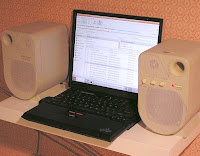I've had a broken Mac Plus gathering dust in my collection for years. It's an all-in-one design with a high-voltage analog board (technical term: monitor guts) that controls the display and a one-piece motherboard (the computer itself). These Macs were fanless: wonderfully silent and cooled by convection, the case acting like a chimney. At least that was the plan. Excess heat and a couple of poor component choices on the analog board resulted in notorious problems like the analog board warping causing solder joints to crack.
I took my Plus apart recently to try to resolder some of the connections in the hope that they were just cracked. That didn't fix the problem, though, so I found a list of common problem components in the pickle's Low-End Mac FAQ and ordered some replacements from Digi-Key.







It won't boot, though. The floppy drive is dirty and possibly broken. I may have to replace it. I also have to dig up a keyboard and mouse (I think I've got both but the mouse has no ball... insert your own joke here) and connect the external SCSI harddrive and see if the SCSI CD-ROM I've got works. I may have to do a bit of shopping on eBay to get this Plus fully functional... or I may try something a bit more radical...
winter's computers
found, loved, and nurtured for spring
my ugly geek secret
Monday 26 November 2007
raising the dead
Saturday 3 November 2007
getneckid
- NEC Versa VX
- 2000
- Intel Pentium III (Coppermine), 450MHz
- 192 MB
- ATI Rage Mobility-M
- 14.1" XGA (1024 x 768) TFT LCD display
- 18 GB harddrive
- CD-ROM
- Wireless (CardBus NIC)
- Microsoft Windows 2000
- TouchPad
- TV Out
- Infrared
getneckid is still slow, of course, but documents load particularly slowly due to the virus scanner (Avast), a component not required for Linux. Opera was working well for her as a web browser, so I installed the Windows version. Overall it seems to be working well so far.
stinky
- IBM Thinkpad T20
- 2000
- Intel Pentium III (Coppermine), 650MHz
- 256 MB
- S3 86C270-294 Savage/IX-MV
- 14.1" XGA (1024x768) TFT LCD display
- 18 GB harddrive
- DVD-ROM
- Wireless (CardBus NIC)
- Ubuntu Linux 6.06 LTS (Dapper Drake)
- ThinkLight, which allows you to see your keyboard in the dark (activated by pressing the leftmost bottom key and topmost right key)
- TrackPoint (nipple mouse)
she had weird issues on stinky as well: it froze often after opening links from Evolution. The web browser seemed to be the culprit, but I tried both Firefox and Opera and the same thing happened. I'm going to install the latest Ubuntu to test it further, and also to investigate the hibernate function which I couldn't get to work, even after I set it up on a FreeDOS partition (hibernation uses a file rather than a partition for saving the hibernation data) and confirmed that it will hibernate from FreeDOS.
Subscribe to:
Posts (Atom)


